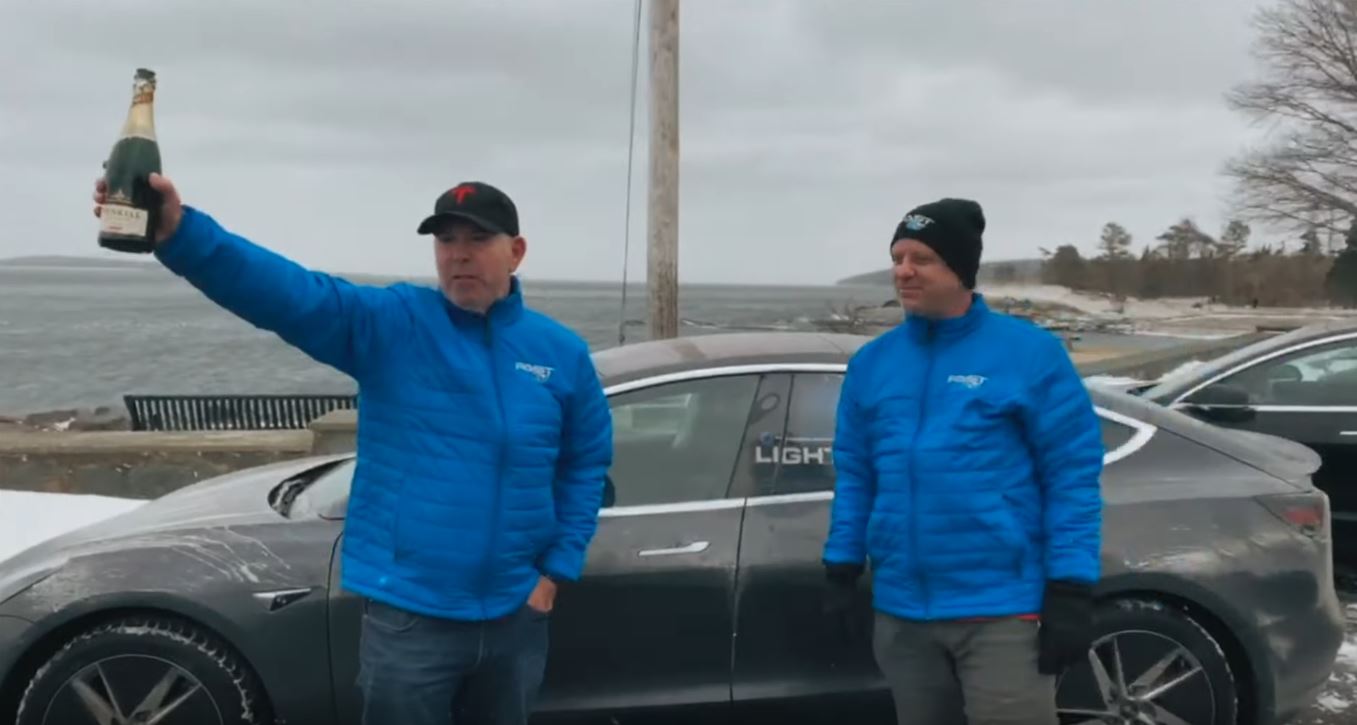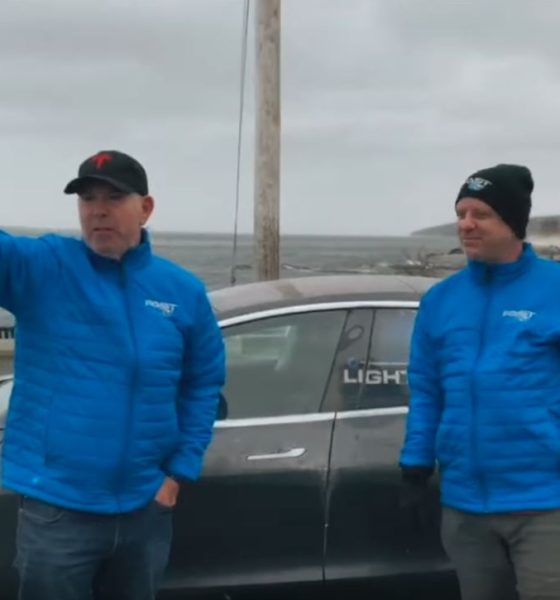

News
Tesla owners Supercharge across Canada in epic coast-to-coast nonstop road trip
A Tesla Model 3 Performance driven by the Ian Pavelko and Trevor Page completed the first-ever Canada coast-to-coast nonstop electric vehicle road trip. The amazing trip, chronicled in a stunning timelapse video, covered 6,131 km. (3,810 miles) during a period of roughly 73.5 hours.
The duo who demonstrated the capability of electric vehicles, particularly the Model 3, and the existing charging networks that support them. The two Tesla owners started their record-setting journey on March 4 and set off from Tsawwassen, British Columbia and ended in Point Pleasant Park in Halifax, Nova Scotia on March 7.
The road trip involved 40 Supercharger stops and made most of the newly opened Trans-Canada Tesla Supercharger route. Of course, there were coffee breaks, a ton of fast food, and a good dose of good music along the way, according to Pavelko and Page. The drivers took turns driving so the other can rest on the passenger seat.
I call this one Full Circle pic.twitter.com/Ri828eUk3z
— Mad (Mostly Ukrainian) Hungarian 🇺🇦 (@IanPavelko) March 10, 2020
“Honestly, this has been one of the most enjoyable and exciting drives I’ve ever done,” Pavelko said on a press release posted on the Tesla Owners Online.
The duo revealed that there were a few setbacks during the journey but they were able to handle them, thanks to the incredible support from locals across Canada and via online channels through their three-day road trip.
“We made a few mistakes along the way. We overcharged at one point and we didn’t plan for certain distances, and of course, weather is always an issue and was for us heading into Halifax, but we’re still really pleased with the 73-hour drive time it took,” said Page.
The tour dubbed as the “Fast EV Lightning Run” was sponsored by Fast EV, a division of Fast Wheels, that equipped the Model 3 with Fast EV01+ wheels specifically designed to maintain the efficiency of electric vehicles.. The trip made most of the chargers along that Trans-Canada Highway, a major transportation artery that traverses the 10 provinces of Canada.
A little video I shot when we got out of the car in Halifax today.
Apologies for the horrible sound but the wind was gusting at 80+ km/h 😳#FastEVLightingRun pic.twitter.com/AxT6CK97Tj— Mad (Mostly Ukrainian) Hungarian 🇺🇦 (@IanPavelko) March 7, 2020
With the success of the first Fast EV Lightning Run, Pavelko and Page look forward to annual drives across Canada with other electric vehicle owners.
“We hope other EV owners will see just how enjoyable this drive can be. Canada is such a beautiful country and we got to see it in all its glory,” Pavelko said.
Ian Pavelko and Trevor Page posted an uncut timelapse video of their Canada coast-to-coast trip on Tesla Owners Online YouTube channel.
Check out the video below:

Elon Musk
Elon Musk and Tesla AI Director share insights after empty driver seat Robotaxi rides
The executives’ unoccupied tests hint at the rapid progress of Tesla’s unsupervised Robotaxi efforts.

Tesla CEO Elon Musk and AI Director Ashok Elluswamy celebrated Christmas Eve by sharing personal experiences with Robotaxi vehicles that had no safety monitor or occupant in the driver’s seat. Musk described the system’s “perfect driving” around Austin, while Elluswamy posted video from the back seat, calling it “an amazing experience.”
The executives’ unoccupied tests hint at the rapid progress of Tesla’s unsupervised Robotaxi efforts.
Elon and Ashok’s firsthand Robotaxi insights
Prior to Musk and the Tesla AI Director’s posts, sightings of unmanned Teslas navigating public roads were widely shared on social media. One such vehicle was spotted in Austin, Texas, which Elon Musk acknowleged by stating that “Testing is underway with no occupants in the car.”
Based on his Christmas Eve post, Musk seemed to have tested an unmanned Tesla himself. “A Tesla with no safety monitor in the car and me sitting in the passenger seat took me all around Austin on Sunday with perfect driving,” Musk wrote in his post.
Elluswamy responded with a 2-minute video showing himself in the rear of an unmanned Tesla. The video featured the vehicle’s empty front seats, as well as its smooth handling through real-world traffic. He captioned his video with the words, “It’s an amazing experience!”
Towards Unsupervised operations
During an xAI Hackathon earlier this month, Elon Musk mentioned that Tesla owed be removing Safety Monitors from its Robotaxis in Austin in just three weeks. “Unsupervised is pretty much solved at this point. So there will be Tesla Robotaxis operating in Austin with no one in them. Not even anyone in the passenger seat in about three weeks,” he said. Musk echoed similar estimates at the 2025 Annual Shareholder Meeting and the Q3 2025 earnings call.
Considering the insights that were posted Musk and Elluswamy, it does appear that Tesla is working hard towards operating its Robotaxis with no safety monitors. This is quite impressive considering that the service was launched just earlier this year.
Elon Musk
Starlink passes 9 million active customers just weeks after hitting 8 million
The milestone highlights the accelerating growth of Starlink, which has now been adding over 20,000 new users per day.

SpaceX’s Starlink satellite internet service has continued its rapid global expansion, surpassing 9 million active customers just weeks after crossing the 8 million mark.
The milestone highlights the accelerating growth of Starlink, which has now been adding over 20,000 new users per day.
9 million customers
In a post on X, SpaceX stated that Starlink now serves over 9 million active users across 155 countries, territories, and markets. The company reached 8 million customers in early November, meaning it added roughly 1 million subscribers in under seven weeks, or about 21,275 new users on average per day.
“Starlink is connecting more than 9M active customers with high-speed internet across 155 countries, territories, and many other markets,” Starlink wrote in a post on its official X account. SpaceX President Gwynne Shotwell also celebrated the milestone on X. “A huge thank you to all of our customers and congrats to the Starlink team for such an incredible product,” she wrote.
That growth rate reflects both rising demand for broadband in underserved regions and Starlink’s expanding satellite constellation, which now includes more than 9,000 low-Earth-orbit satellites designed to deliver high-speed, low-latency internet worldwide.
Starlink’s momentum
Starlink’s momentum has been building up. SpaceX reported 4.6 million Starlink customers in December 2024, followed by 7 million by August 2025, and 8 million customers in November. Independent data also suggests Starlink usage is rising sharply, with Cloudflare reporting that global web traffic from Starlink users more than doubled in 2025, as noted in an Insider report.
Starlink’s momentum is increasingly tied to SpaceX’s broader financial outlook. Elon Musk has said the satellite network is “by far” the company’s largest revenue driver, and reports suggest SpaceX may be positioning itself for an initial public offering as soon as next year, with valuations estimated as high as $1.5 trillion. Musk has also suggested in the past that Starlink could have its own IPO in the future.
News
NVIDIA Director of Robotics: Tesla FSD v14 is the first AI to pass the “Physical Turing Test”
After testing FSD v14, Fan stated that his experience with FSD felt magical at first, but it soon started to feel like a routine.

NVIDIA Director of Robotics Jim Fan has praised Tesla’s Full Self-Driving (Supervised) v14 as the first AI to pass what he described as a “Physical Turing Test.”
After testing FSD v14, Fan stated that his experience with FSD felt magical at first, but it soon started to feel like a routine. And just like smartphones today, removing it now would “actively hurt.”
Jim Fan’s hands-on FSD v14 impressions
Fan, a leading researcher in embodied AI who is currently solving Physical AI at NVIDIA and spearheading the company’s Project GR00T initiative, noted that he actually was late to the Tesla game. He was, however, one of the first to try out FSD v14.
“I was very late to own a Tesla but among the earliest to try out FSD v14. It’s perhaps the first time I experience an AI that passes the Physical Turing Test: after a long day at work, you press a button, lay back, and couldn’t tell if a neural net or a human drove you home,” Fan wrote in a post on X.
Fan added: “Despite knowing exactly how robot learning works, I still find it magical watching the steering wheel turn by itself. First it feels surreal, next it becomes routine. Then, like the smartphone, taking it away actively hurts. This is how humanity gets rewired and glued to god-like technologies.”
The Physical Turing Test
The original Turing Test was conceived by Alan Turing in 1950, and it was aimed at determining if a machine could exhibit behavior that is equivalent to or indistinguishable from a human. By focusing on text-based conversations, the original Turing Test set a high bar for natural language processing and machine learning.
This test has been passed by today’s large language models. However, the capability to converse in a humanlike manner is a completely different challenge from performing real-world problem-solving or physical interactions. Thus, Fan introduced the Physical Turing Test, which challenges AI systems to demonstrate intelligence through physical actions.
Based on Fan’s comments, Tesla has demonstrated these intelligent physical actions with FSD v14. Elon Musk agreed with the NVIDIA executive, stating in a post on X that with FSD v14, “you can sense the sentience maturing.” Musk also praised Tesla AI, calling it the best “real-world AI” today.








